
We all know that all volleyball moves (setting, spiking hitting, serving, digging …) involve using hands to be executed. However, some beginners (especially those with a soccer background) keep wondering whether using legs is allowed in volleyball or not!
You will be surprised, but legs are currently allowed in volleyball. You can even use them intentionally for defending or attacking purposes. However, there are some few exceptions when the use of legs won’t be considered as legal.
In this article, I breakdown cases where you are good to go when it comes to using your legs and other cases where you should not.
Do regulations allow using legs in volleyball?
The regulations surrounding contact of the volleyball below the waist, specifically with your leg, have changed substantially over the years…
Earlier, if the ball used to hit a body part below the waist, it was pronounced as out of play, and a point was awarded to the opponent team.
However, this is not the case anymore….
A change of rule now allows the use of any body part to come in contact and hit the ball. Therefore, it is legal for the ball to be struck by a player’s foot and still continue to be in play.
However, a player serving the ball may not have their foot touch the baseline before coming in contact with the ball. If their foot touches the line first, it is said to be a foot fault, so the ball and a point get awarded to the other team.
There are also rotational rules that govern the positioning of a player, that state that the foot of a front-row player has to be closer to the centerline than the feet of the corresponding back-row player.
So if a volleyball player determines that the only way for them to reach or dig the ball is with their foot, then it is perfectly acceptable under the rules to make that play with their leg and continue the rally.
Quick Recommendation: There are many obscure volleyball rules that not many players know about (like the use of legs). That’s why I highly recommend you continue learning about the rules as this will help improve you as a player. For example, this Amazing Resource explains the sport in general and the rules in particular in a very simple manner.
It is important to keep in mind that you cannot use your foot to trap the ball! For example, in soccer, a skilled player can trap the ball on his foot out of the air…
However, while a volleyball player might be able to do this, it would be considered illegal to do so.
The rules of volleyball state that the ball has to be hit, not caught. If the ball strikes your foot but does not rebound, then it will be considered to be a fault. In such a case, a point would get awarded to the opposing team.
How many times you can use your leg in volleyball?
Any player on the team can hit the ball up to three times on their side of the net, with the third hit ensuring that the ball goes over the net to the opposing team.
This also includes any kicks being used…
If the team hits the ball a 4 time before returning it to the other team, it is considered a fault, and the other team gets awarded a point.
Individual players can only strike the ball once before another player plays it…
If you come in contact with the ball twice for example, you kick it and then hit it with your hand, it will also be considered to be a fault.
In which situations you may want to use your leg?
Kicking the ball is usually kept as a last resort for any volleyball player. In general, it is deemed to be unique to kick the ball even though it is legal to do so.
Your hands and arms are known to provide better control over the ball, and this allows you to better direct the ball where you want it to go.
You can kick the ball if, for instance, you have fallen down and are unable to reach the ball with your hands.
In such a case, you can try to keep the ball in play by kicking it with your foot. In fact, 99% of all ball kicks in volleyball only happen because players have to save the ball.
There are also some situations when using your feet is perfectly acceptable. Here are some common situations that may happen in almost every game.
Defense
Whether by accident or as a last attempt, kicking the ball up with your foot can sometimes be the only way to save a ball in defense…
In fact, just when you are standing at the right defensive position, you would be surprised to see how often your feet will be able to save the ball.
At the Net
This situation does not refer to blocking the ball with your feet. We are, instead, referring to playing the ball quickly with your feet after a block.
This is one of the most common situations that call for using your feet in volleyball.
After blocking, you land and turn to see where the ball is in defense. The reaction time is quick, and when your defense makes a great play, but the ball is shooting low at your feet, you won’t have the time to bend down and play it with your hands.
It is common to flick it upwards with your foot, and many setters are incredibly good at this move.
The Chase
The most spectacular foot saves that go up on the walls of popular sites are the ones that many of us have commonly seen.
Players jump over the barriers, sprawl out, crash into banners and advertisements, and while chasing down a ball out of court, you will find yourself having more control performing a swan dive…
However, in some drastic circumstances, or when there are obstacles that you don’t want to be diving face-first into, kicking a leg out at the ball can be a great option of saving the move.
Do coaches recommend using legs?
Most coaches usually do not recommend kicking the ball in volleyball. In fact, kicking the ball with any part of the body other than your hands and arms is usually a sign that you are not in control of that specific situation…
Usually, when players are running to save the ball, and they almost get it, but there is not enough time to receive it with their hands, then they may decide to use their legs.
In general, your hands and arms provide better control and allow you to direct the ball where you want it to go.
Kicking the ball is usually the last resort for most players. For example, if you have fallen down and are unable to reach the ball with your hands, you may attempt to keep the ball in play by using your foot.
Coaches usually do not recommend kicking the ball because not only it is hard to direct the ball, but it can sometimes also be dangerous, especially when a player is chasing after the ball.
What about beach volleyball?
There is a rare difference in the rules between beach and indoor volleyball, apart from the number of players and court size, it is that the center line rule is quite different between the two sports.
When volleyball is played indoors, the athlete has to avoid letting any foot completely cross into the other team’s court…
However, in the outdoor beach volleyball game, a player can cross over entirely into the other team’s court under the net, assuming they do not interfere with game play. Due to this, the feet play a vital role in beach volleyball as well.
Kicking the ball in beach volleyball is also legal, and it is also considered to be safer since you are playing on a soft sandy surface…
Again, though, it is equally rare to see a player kick a beach volleyball. It is also allowed to use any part of the body to make contact with the volleyball, and the ball will continue to remain in play.
When a player hits the beach volleyball with their foot, it counts as one of the three hits of the team, and the play keeps going on.
Final Thoughts …
One more detail that I want to add, is that volleyball shoes are not really adapted to be used to hit the ball anyway. They are not like soccer shoes for example that are adapted to the ball touch …
If you take a look at these volleyball shoes for example, it is clear that they are completely different from regular soccer shoes.
Finally, I highly invite you to check those 2 important articles:
